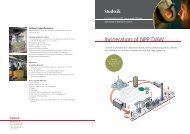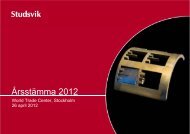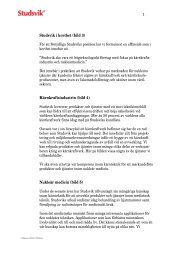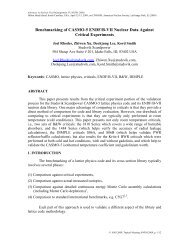Robust PCI Monitoring During PWR Operation at ... - Studsvik
Robust PCI Monitoring During PWR Operation at ... - Studsvik
Robust PCI Monitoring During PWR Operation at ... - Studsvik
- No tags were found...
Create successful ePaper yourself
Turn your PDF publications into a flip-book with our unique Google optimized e-Paper software.
Proceedings of 2010 LWR Fuel Performance/TopFuel/WRFPMOrlando, Florida, USA, September 26-29, 2010Paper 097Fig. 5. Nodal delta-kW/ft/hr during Open Valve Test vs.TimeThe nodal delta-kW/ft/hr values presented in thefigure coincide with the expected behavior. <strong>During</strong> theevent nodes where power is being suppressed as the leadcontrol bank is inserted experience a neg<strong>at</strong>ive deltakW/ft/hr.Conversely, nodes where power is beingincreased as the lead control bank is withdrawn experiencea positive delta-kW/ft/hr. The magnitude of the changes (indelta-kW/ft/hr) are consistent with the expected increase inclad strain – a key component of <strong>PCI</strong> – given th<strong>at</strong> the leadcontrol bank movement occurs over a rel<strong>at</strong>ively short time.The event was also evalu<strong>at</strong>ed with the delta-kW/ftapproach by using d<strong>at</strong>a for each fuel pin in the core (d<strong>at</strong>awhich is typically not available during oper<strong>at</strong>ionaltransients).Exploring the same plot of delta-kW/ft/hr with d<strong>at</strong>afor every pin in every node in the core (Fig. 6.) highlightsone major inadequacy of this monitoring method – namelyth<strong>at</strong> it ignores local (pin-level) changes, which can besignificantly larger in magnitude than more coarse nodewised<strong>at</strong>a.This pin d<strong>at</strong>a is compared with the nodal results andpresented as Fig.6. Note th<strong>at</strong> in the following plot, the d<strong>at</strong>ain red is pin-by-pin delta-kw/ft/hr, while the d<strong>at</strong>a in blackis the nodal delta-kw/ft/hr.Fig. 6. Pin-by-Pin Margin-to-<strong>PCI</strong> during Open Valve TestThe results demonstr<strong>at</strong>e th<strong>at</strong> using nodal d<strong>at</strong>a vs.detailed pin inform<strong>at</strong>ion does not show the significantlyhigher changes in LHGR th<strong>at</strong> individual pins couldexperience during a power transient. (Even though for thisparticular case there is not sufficient evidence, even withthermo-mechanical fuel performance analysis to support<strong>PCI</strong> failure.)Finally, neither the nodal d<strong>at</strong>a based delta-kW/ft/hrmodel nor the pin-by-pin delta-kW/ft/hr models aresufficient for diagnosing <strong>PCI</strong>. <strong>PCI</strong> is predic<strong>at</strong>ed not only inchanges in kW/ft but also a time component (e.g., howquickly the changes have occurred, has the fuel claddingbeen conditioned to the higher LHGR, etc.).V. B. Threshold LHGR Results for Results for OpenValve TestUsing the same detailed pin-by-pin LHGR d<strong>at</strong>agener<strong>at</strong>ed from CMSOps during the open valve test, thealtern<strong>at</strong>ive threshold model 8 was applied. As previouslymentioned, this model requires certain constants for thecomponents for monitoring (e.g., conditioning/deconditioningr<strong>at</strong>es, etc.).The results presented in Fig. 7. indic<strong>at</strong>es similarmargin for the most limiting pin during the transient usingthe threshold model and empirical d<strong>at</strong>a from <strong>Studsvik</strong>Nuclear 9 .In the figure the inlet temper<strong>at</strong>ure vs. time during theevent is plotted against the right-side y-axis and the leadcontrol bank position on the left-side y-axis.
















